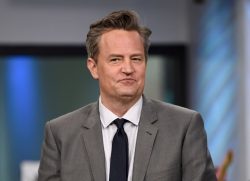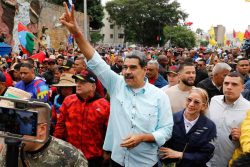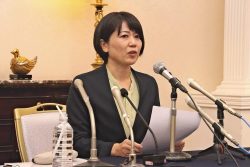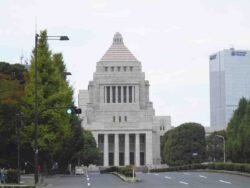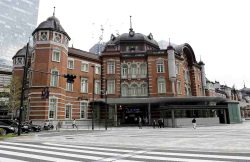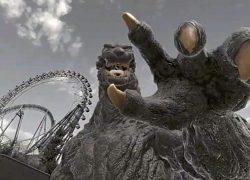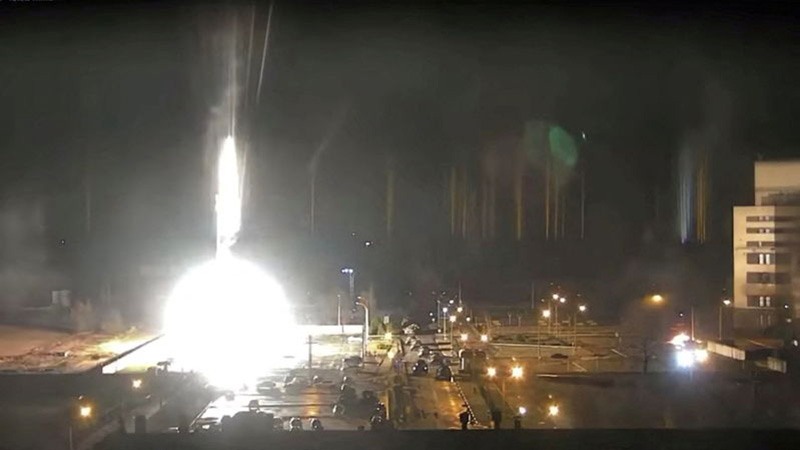
Surveillance camera footage shows a flare landing at the Zaporizhzhia nuclear power plant during shelling in Enerhodar, Zaporizhia Oblast, Ukraine March 4, 2022, in this screengrab from a video obtained from social media.
13:29 JST, March 4, 2022
KYIV, Ukraine (AP) — Russian forces shelled Europe’s largest nuclear plant early Friday in the battle for control of a crucial energy-producing city, and the power station was on fire.
Plant spokesman Andriy Tuz told Ukrainian television that shells were falling directly on the Zaporizhzhia plant and had set fire to one of the facility’s six reactors. That reactor is under renovation and not operating, but there is nuclear fuel inside, he said.
Firefighters cannot get near the fire because they are being shot at, Tuz said.
A government official told The Associated Press that elevated levels of radiation were detected near the site of the plant, which provides about 25% of Ukraine’s power generation. The official spoke on condition of anonymity because the information has not yet been publicly released.
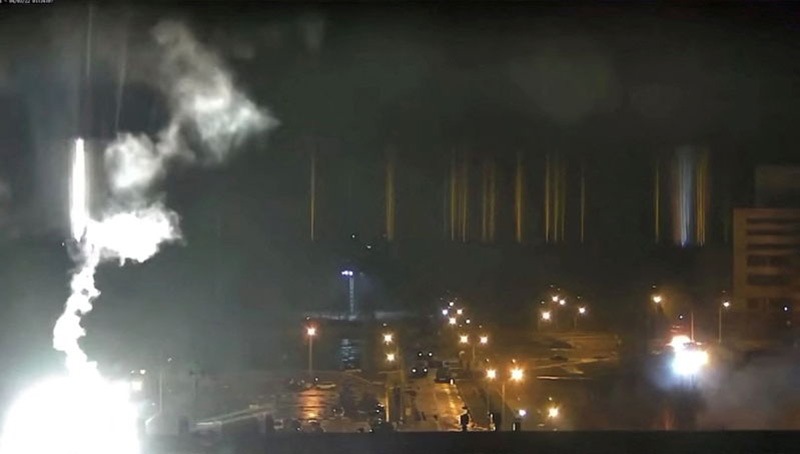
Surveillance camera footage shows a flare landing at the Zaporizhzhia nuclear power plant during shelling in Enerhodar, Zaporizhia Oblast, Ukraine March 4, 2022, in this screengrab from a video obtained from social media.
Tuz said it is urgent to stop the fighting to put out the flames.
The fighting at Enerhodar, a city on the Dnieper River, came as another round of talks between the two sides yielded a tentative agreement to set up safe corridors inside Ukraine to evacuate citizens and deliver humanitarian aid.
Elsewhere, Russian forces gained ground in their bid to cut off the country from the sea, as Ukrainian leaders called on citizens to rise up and wage guerrilla war against the invaders.
While the huge Russian armored column threatening Kyiv appeared bogged down outside the capital, Vladimir Putin’s forces have brought their superior firepower to bear over the past few days, launching hundreds of missiles and artillery attacks on cities and other sites around the country and making significant gains in the south.
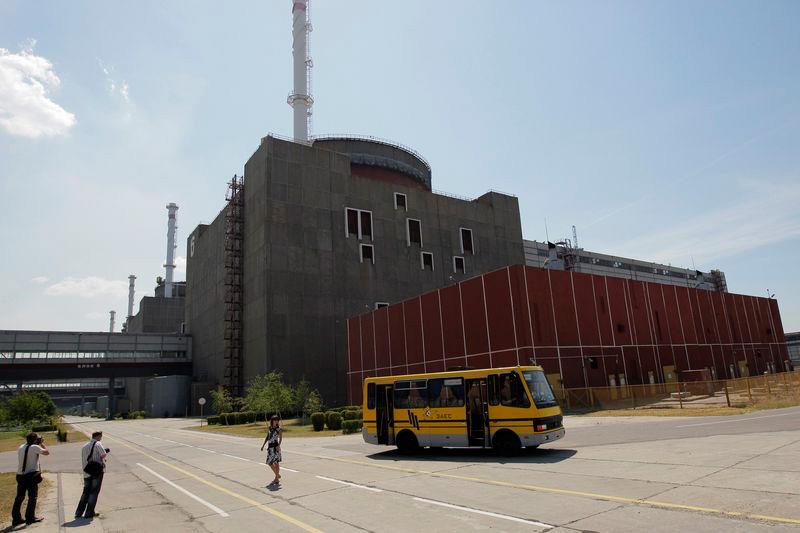
A general view of the Zaporizhzhia nuclear power station in Ukraine in this June 12, 2008.
The mayor of Enerhodar said Ukrainian forces were battling Russian troops on the city’s outskirts. Video showed flames and black smoke rising above the city of more than 50,000, with people streaming past wrecked cars, just a day after the U.N. atomic watchdog agency expressed grave concern that the fighting could cause accidental damage to Ukraine’s 15 nuclear reactors.
Mayor Dmytro Orlov and the Ukrainian state atomic energy company reported that a Russian military column was heading toward the nuclear plant. Loud shots and rocket fire were heard late Thursday.
“Many young men in athletic clothes and armed with Kalashnikovs have come into the city. They are breaking down doors and trying to get into the apartments of local residents,” the statement from Energoatom said.
Ukrainian Prime Minister Denys Shmyhal called on the West to close the skies over the country’s nuclear plants as fighting intensified. “It is a question of the security of the whole world!” he said in a statement.
The U.S. and NATO allies have ruled out creating a no-fly zone since the move would pit Russian and Western military forces against each other.
The Russians announced the capture of the southern city of Kherson, a vital Black Sea port of 280,000, and local Ukrainian officials confirmed the takeover of the government headquarters there, making it the first major city to fall since the invasion began a week ago.
Heavy fighting continued on the outskirts of another strategic port, Mariupol, on the Azov Sea. The battles have knocked out the city’s electricity, heat and water systems, as well as most phone service, officials said. Food deliveries to the city were also cut.
Associated Press video from the port city shows the assault lighting up the darkening sky above largely deserted streets and medical teams treating civilians, including one inside a clinic who appeared to be a child. Doctors were unable to save the person.
Severing Ukraine’s access to the Black and Azov seas would deal a crippling blow to its economy and allow Russia to build a land corridor to Crimea, seized by Moscow in 2014.
Overall, the outnumbered, outgunned Ukrainians have put up stiff resistance, staving off the swift victory that Russia appeared to have expected. But a senior U.S. defense official, speaking on condition of anonymity, said Russia’s seizure of Crimea gave it a logistical advantage in that part of the country, with shorter supply lines that smoothed the offensive there.
Ukrainian leaders called on the people to defend their homeland by cutting down trees, erecting barricades in the cities and attacking enemy columns from the rear. In recent days, authorities have issued weapons to civilians and taught them how to make Molotov cocktails.
“Total resistance. … This is our Ukrainian trump card, and this is what we can do best in the world,” Oleksiy Arestovich, an aide to Ukrainian President Volodymyr Zelenskyy, said in a video message, recalling guerrilla actions in Nazi-occupied Ukraine during World War II.
In a video address to the nation, Zelenskyy praised his country’s resistance.
The Russians “will have no peace here. They will have no food,” he said. “They will have not one quiet moment.”
The second round of talks between Ukrainian and Russian delegations was held in neighboring Belarus. But the two sides appeared far apart going into the meeting, and Putin warned Ukraine that it must quickly accept the Kremlin’s demand for its “demilitarization” and declare itself neutral, renouncing its bid to join NATO.
Putin told French President Emmanuel Macron he was determined to press on with his attack “until the end,” according to Macron’s office.
The two sides said that they tentatively agreed to allow cease-fires in areas designated safe corridors, and that they would seek to work out the necessary details quickly. A Zelenskyy adviser also said a third round of talks will be held early next week.
Despite a profusion of evidence of civilian casualties and destruction of property by the Russian military, Putin decried what he called an “anti-Russian disinformation campaign” and insisted that Moscow uses “only precision weapons to exclusively destroy military infrastructure.”
Putin claimed that the Russian military had already offered safe corridors for civilians to flee, but he asserted without evidence that Ukrainian “neo-Nazis” were preventing people from leaving and were using them as human shields.
He also hailed Russian soldiers as heroes in a video call with members of Russia’s Security Council, and ordered additional payments to families of men killed or wounded.
A top Russian officer, Maj. Gen. Andrei Sukhovetsky, commander of an airborne division, was killed in the fighting earlier this week, an officers organization in Russia reported.
The Pentagon set up a direct communication link to Russia’s Ministry of Defense earlier this week to avoid the possibility of a miscalculation sparking conflict between Moscow and Washington, according to a U.S. defense official who spoke on condition of anonymity because the link had not been announced.
The fighting has sent more than 1 million people fleeing Ukraine, according to the U.N., which fears those refugee numbers could skyrocket.
Ukrainians still in the country faced another grim day. In Kyiv, snow gave way to a cold, gray drizzle, as long lines formed outside the few pharmacies and bakeries that remained open.
More shelling was reported in the northern city of Chernihiv, where emergency officials said at least 33 civilians had been killed in the bombardment of a residential area.
Families with children fled via muddy and snowy roads in the eastern region of Donetsk, while military strikes on the village of Yakovlivka destroyed 30 homes, leaving three people dead, authorities said.
In Kharkiv, Ukraine’s second-largest city, with about 1.4 million people, residents desperate to escape the bombings crowded the railroad station and squeezed onto trains, not always knowing where they were headed.
In the south, Russian troops appeared to roll from Kherson toward Mykolaiv, another major Black Sea port and shipbuilding center to the west. A U.S. defense official said the Russians may want to set up a base in Mykolaiv ahead of a ground offensive against Odesa, Ukraine’s largest port city, which is also home to a large naval base.
The immense Russian column of hundreds of tanks and other vehicles still appeared to be stalled roughly 25 kilometers (16 miles) from Kyiv and had made no real progress in days, amid fuel and food shortages, according to U.S. authorities.
Russia has fired more than 480 missiles in the invasion, according to the U.S. Ukrainian officials boasted that their missile-defense systems shot down many of them.
At least 227 civilians have been killed and 525 wounded, according to the office of the U.N. High Commissioner for Human Rights, though it acknowledged that is a vast undercount, and Ukraine said more than 2,000 civilians have died. The figures could not be independently verified.
Russia reported its military casualties Wednesday for the first time in the war, saying nearly 500 of its troops have been killed and almost 1,600 wounded. Ukraine insisted Russia’s losses are many times higher but did not disclose its own military casualties.
"News Services" POPULAR ARTICLE
-

American Playwright Jeremy O. Harris Arrested in Japan on Alleged Drug Smuggling
-

Taiwan President Shows Support for Japan in China Dispute with Sushi Lunch
-

Japan’s Nikkei Stock Average as JGB Yields, Yen Rise on Rate-Hike Bets
-

Japan’s Nikkei Stock Average Licks Wounds after Selloff Sparked by BOJ Hike Bets (UPDATE 1)
-

Japanese Bond Yields Zoom, Stocks Slide as Rate Hike Looms
JN ACCESS RANKING
-

Japan’s Hopes for Seafood Exports Shot Down in China Spat
-

Keidanren Chairman Yoshinobu Tsutsui Visits Kashiwazaki-Kariwa Nuclear Power Plant; Inspects New Emergency Safety System
-

Japan to Charge Foreigners More for Residence Permits, Looking to Align with Western Countries
-

Imports of Rare Earths from China Facing Delays, May Be Caused by Deterioration of Japan-China Relations
-

Japan Exports Rise in October as Slump in U.S. Sales Eases


